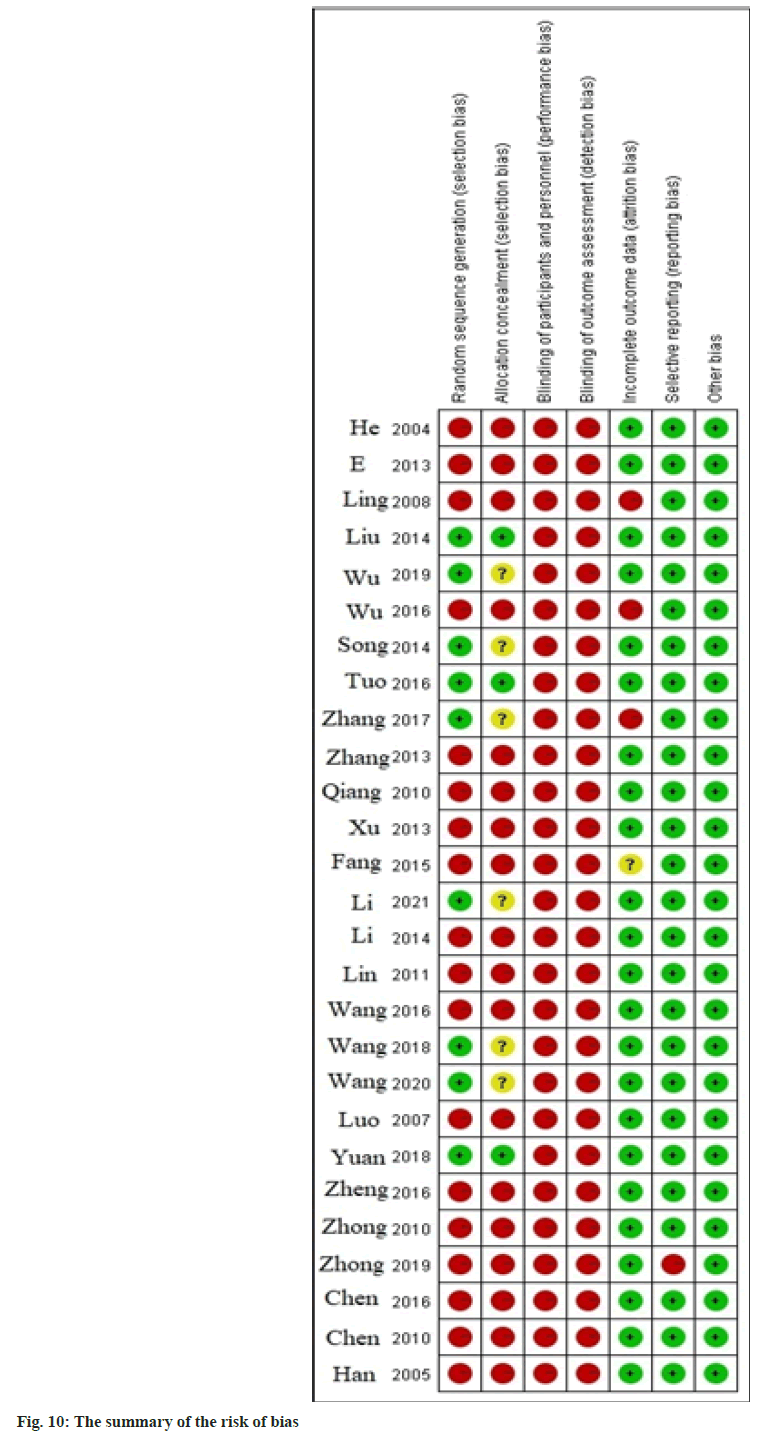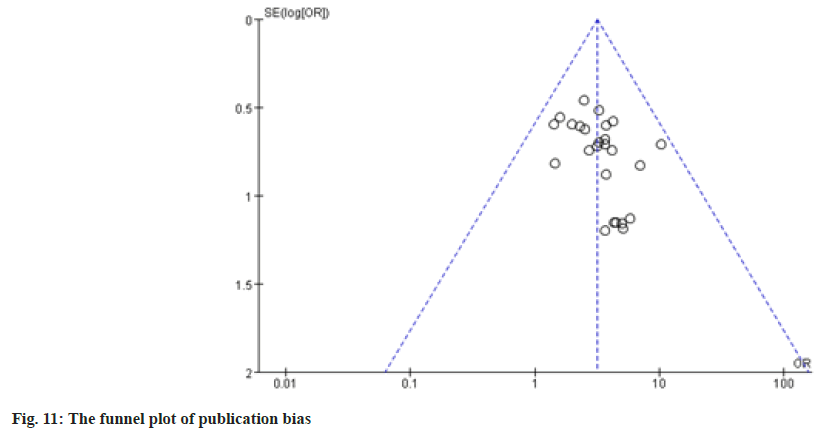- *Corresponding Author:
- Xiaoqing Ding
Department of Blood, Dong fang Hospital of Beijing University of Chinese Medicine, Beijing 100078, China
E-mail: dxiaoqing8690@163.com
| This article was originally published in a special issue, “Current Trends in Pharmaceutical and Biomedical Sciences” |
| Indian J Pharm Sci 2022:84(5) Spl Issue “30-39” |
This is an open access article distributed under the terms of the Creative Commons Attribution-NonCommercial-ShareAlike 3.0 License, which allows others to remix, tweak, and build upon the work non-commercially, as long as the author is credited and the new creations are licensed under the identical terms
Abstract
A systematic review of the efficacy and safety of Jianpi Yiqi combined with glucocorticoids in the treatment of immune thrombocytopenic purpura. Randomized controlled trial of Jianpi Yiqi therapy combined with glucocorticoid therapy for immune thrombocytopenic purpura was retrieved without any restrictions on blindness and language. Randomized controlled trial that met the inclusion criteria were screened, and the Revman5.3 software was used for meta-analysis. A total of 27 articles were included with 1716 cases. The results of the meta-analysis showed that in terms of the effective rate of Western medicine, the effect of Jianpi Yiqi combined with glucocorticoid therapy were significantly better than that of glucocorticoid therapy alone, with a statistically significant difference (p<0.0001). The combination of traditional Chinese and Western medicine is better than hormone therapy in improving the efficiency of traditional Chinese medicine, platelet count, syndrome score, interleukin-10 and cluster of differentiation 4/cluster of differentiation 8 levels. The effect of Jianpi Yiqi combined with glucocorticoid in the treatment of immune thrombocytopenic purpura is better than that of glucocorticoid alone, which is worthy of further study and promotion.
Keywords
Immune thrombocytopenic purpura, Jianpi Yiqi, glucocorticoids, meta-analysis
Immune Thrombocytopenic Purpura (ITP) is a common autoimmune hematologic disease characterized by bleeding. Current studies mostly believe that it is related to patient’s platelet destruction caused by unknown reasons. Patients with platelet destruction caused by their platelet antibody produced too much and in turn, subcutaneous and visceral bleeding symptoms, for patients with mild, platelet destruction to a lesser degree, more than with symptomatic treatment is given priority and the low level of platelet repeated clinical symptoms of patients, preferred glucocorticoid treatment, also reflected the good curative effect in clinical at present[1]. However, the disease is prone to relapse and long-term use of hormones has certain side effects, so the combined use of Traditional Chinese Medicine (TCM) has obvious advantages in reducing the dose and cycle of hormones, reducing the side effects of hormones and enhancing the efficacy of hormones[2]. At present, the relevant systematic reviews are mostly limited to the treatment of integrated traditional Chinese and Western medicine, without a precise treatment plan, so they lack certain value for the determination of a clinical treatment plan. The purpose of this study is to compare the efficacy and safety of Jianpi Yiqi combined with glucocorticoid compared with glucocorticoid alone, to produce more precise guiding significance for clinical treatment and it is expected to have certain guiding value for the future exploration of more safe and effective treatment programs.
Materials and Methods
Inclusion criteria:
Clinical Randomized Controlled Trial (RCT) study of Jianpi Yiqi combined with glucocorticoid in the treatment of ITP, speechless and blinded, from the establishment of the database to December 2021; complete information and necessary data of curative effect evaluation indexes can be obtained; experimental design clear information contained in the experimental group and control group, the experimental group of TCM treatment should be "Jianpi" or "Yiqi" treatment (no dosage form), may contain "Jianpi" and "Yiqi", the paper made clear that a similar, but not limited to the text, the method of main treatment scheme should be the same as the experimental group and Western medicine treatment control group; the main treatment plan of Western medicine is a glucocorticoid (dose and trade name are not limited) and other conventional treatment includes symptomatic and supportive treatment such as blood transfusion, hemostasis and nutritional supplementation.
Exclusion criteria:
Non-clinical trials (including animal experiments, reviews, etc.); the TCM treatment in the treatment group included acupuncture and moxibustion in addition to oral Chinese medicine, which may affect the treatment effect; randomization method is not true; the test data cannot be reconstructed and clinical trials focused on children.
The object of study:
Adult patients with a definite diagnosis of ITP have no upper age limit, race or gender.
Outcome indicators:
The efficacy of Western medicine was evaluated according to the ITP efficacy standard formulated by the 2nd National Conference on Hematology.
ITP TCM syndrome score evaluation criteria:
According to the nimodipine method, peripheral blood image contains platelet count and other indicators.
Syndrome efficacy index (N)=(Total score before treatment-total score after treatment)/total score before treatment×100 %
Other outcome measures: Adverse reactions, mortality and other peripheral blood features.
Literature search strategy:
The Chinese Biomedical Literature Database (CBM), China National Knowledge Infrastructure (CNKI), Chongqing VIP Full-text Database (VIP), Wan fang Database and PubMed combined with Jianpi Yiqi were searched electronically until December 2021. Glucocorticoid treated RCTs of ITP without language limitation. With "thrombocytopenic purpura", "ITP", "Jianpi", "Yiqi" and "random" as the theme words and free words.
Literature screening:
First, two researchers manually screened the originally included literature independently to exclude the literature that did not meet the requirements and then read the full text to screen the included target literature. Controversial documents should be judged independently by other researchers. If there are still disputes, they can be discussed and settled.
The evaluation of the quality of the included studies:
The Cochrane "Risk of Bias Assessment" tool was used to evaluate the randomized sequence generation, hidden assignment, blinding, data integrity, reporting selectivity, publication bias and other issues in the included literature.
Data extraction:
A data extraction table was developed by the research team to extract baseline conditions, interventions and efficacy outcomes. The existing problem data can be checked by the original literature or solved by discussion.
Statistical method:
RevMan 5.3 software was used for meta-analysis. Enumeration data were expressed as effect size (OR) and 95 % Confidence Interval (CI). When the results were homogenous or heterogeneous, the fixed effect model and random effect model were used for meta- analysis. The Cochrane risk bias assessment tool was used for risk assessment and grading of evidence quality.
Results and Discussion
A total of 595 articles were retrieved, 238 duplicate articles were excluded, 108 non-clinical studies were excluded, 70 non-RCT studies were excluded, 80 articles were related to children and 72 articles were not following the relevant treatment methods. Finally, 27 articles were included, including 1716 patients. Specific features of the included literature are shown in Table 1[3-29].
| No. | Case | Period (month) | Treatment | Refernces |
|---|---|---|---|---|
| 1 | 30 | 3 | Invigorating spleen and kidney | [3] |
| 2 | 15 | 4 | Invigorating spleen and kidney | [4] |
| 3 | 40 | 6 | Jian Pi Sheng Xue Tang | [5] |
| 4 | 50 | 6 | Jian Pi Sheng Xue Tang | [6] |
| 5 | 24 | 6 | Yi Qi Huan Ban Tang | [7] |
| 6 | 22 | 6 | Tonifying kidney and spleen | [8] |
| 7 | 25 | 1 | Jian Pi Bu Shen Qing Ren Liang Xue Fang | [9] |
| 8 | 19 | 0.75 | Invigorate spleen and Qi and invigorate blood | [10] |
| 9 | 20 | 0.75 | Jian Pi Yi Qi She Xue granules | [11] |
| 10 | 103 | 0.75 | Invigorate spleen and Qi and invigorate blood | [12] |
| 11 | 45 | 3 | Invigorating spleen to eliminate dampness | [13] |
| 12 | 30 | 3 | Invigorate spleen and kidney and deflate fire | [14] |
| 13 | 56 | 3 | Benefiting qi and nourishing yin | [15] |
| 14 | 23 | 1 | Yi Qi Bu Xue tablets | [16] |
| 15 | 30 | 1 | Yi Qi Jian Pi Hua Shi Fang | [17] |
| 16 | 32 | 4 | Yi Qi Liang Xue Tang | [18] |
| 17 | 30 | 3 | Jia Jian Gui Pi Tang | [19] |
| 18 | 26 | 1 | Bu She Yi Qi Liang Xue Jie Du Tang | [20] |
| 19 | 30 | 3 | Yi Qi She Xue Tang | [21] |
| 20 | 38 | 2 | Yi Qi Sheng Hua Tang | [22] |
| 21 | 36 | 6 | Bu Zhong Yi Qi Tang | [23] |
| 22 | 26 | 1 | Reinforcing qi and nourishing blood | [24] |
| 23 | 26 | 6 | Yi Qi Hua Ban Tang | [25] |
| 24 | 30 | 6 | She Xue pill | [26] |
| 25 | 30 | 3 | Hei Gui Pi Tang | [27] |
| 26 | 28 | 1 | Invigorating spleen and kidney | [28] |
| 27 | 30 | 3 | Invigorating spleen and kidney | [29] |
Table 1: Literature Characteristics
A total of 25 studies with 1510 subjects were included. There was no statistical heterogeneity among the 25 studies (χ2=10.53, DF=24 (p=0.99); I2=0 %) as shown in fig. 1. Fixed-effect model meta-analysis indicated that Jianpi Yiqi combined with glucocorticoid in the treatment of ITP had a significantly better improvement effect than hormone therapy alone (OR: 3.12, 95 % CI: 2.38, 4.09) and the difference was statistically significant (p<0.00001).
A total of 9 studies with 600 subjects were included. There was no statistical heterogeneity among the 9 studies (χ2=14.55, DF=8 (p=0.07); I2=45 %) as shown in fig. 2. Meta-analysis using a fixed-effect model suggested that Jianpi Yiqi combined with glucocorticoid in the treatment of ITP had a significantly better improvement effect than hormone therapy alone (OR: 4.24, 95 % CI: 2.80, 6.40), the difference was statistically significant (p<0.00001).
A total of 24 studies with 1451 subjects were included. There was some heterogeneity among the 24 studies (χ2=43.58, DF=23 (p=0.006); I2=47 %) as shown in fig. 3. The experimental heterogeneity was low and the fixed-effect model meta-analysis suggested that Jianpi Yiqi combined with glucocorticoid was significantly better than hormone therapy alone in improving the change of platelet count level in ITP (MD=15.79, 95 % CI (14.06,17.51), Z=17.90, the difference was statistically significant, p<0.00001).
A total of 7 studies with 507 subjects were included. There was statistical heterogeneity among the five studies (χ2=12.67, DF=6 (p=0.05); I2=53 %) as shown in fig. 4. There was heterogeneity in the experiment and the random effect model of the meta-analysis suggested that the combined treatment of traditional Chinese and Western medicine was more effective in improving TCM symptoms than hormone therapy alone (MD=- 1.63, 95 % CI (-2.33, -0.93), Z=4.58. The difference was statistically significant (p<0.00001).
A total of 220 subjects were included in 4 studies. There was statistical heterogeneity among the four studies (Tau2=23.54, χ2=13.68, DF =3 (p=0.003); I2=78 %) as shown in fig. 5, there was high heterogeneity. The random effect model was used in the meta-analysis, suggesting that the Jianpi Yiqi method combined with hormone had an obvious effect on reducing platelet- related antibodies in patients with ITP (MD=-15.19, 95 % CI (-21.88,-8.51), Z=4.45. p<0.00001).
A total of 158 subjects were included in 3 studies. There was statistical heterogeneity among the three studies (Tau2=97.20, χ2=49.05, DF=2 (p<0.00001); I2=96 %) as shown in fig. 6. There was high heterogeneity in the experiment. The random effect model was used for meta-analysis, suggesting that the Jianpi Yiqi method combined with hormone had no significant difference in improving the level of the thrombocytopenic megakaryocyte of ITP patients (MD=6.25, 95 % CI (-5.23,17.74), Z=1.07. p=0.29).
A total of 160 subjects were included in 3 studies. There was statistical heterogeneity among the three studies (Tau2=0.00, χ2=1.24, DF=2 (p=0.54); I2=0 %) as shown in fig. 7. There was low heterogeneity in the experiment. Meta-analysis using the fixed-effect model suggested that Jianpi Yiqi combined with hormones had a significant effect on increasing Interleukin (IL)- 10 levels in patients with ITP (MD=1.24, 95 % CI (7.21,10.76), Z=9.91. p<0.00001).
A total of 146 subjects were included in 3 studies. Heterogeneity among the three studies was low (χ2=2.46, DF=2 (P=0.29); I2=19 %) as shown in fig. 8. The fixed effects model was used in the meta-analysis, suggesting that Jianpi Yiqi combined with glucocorticoid could significantly increase the level of Cluster of Differentiation (CD) 4/CD8 cells (MD=0.13, 95 % CI (0.07.15, 0.19)). Z=4.17, the difference was statistically significant, p<0.0001).
The methodological quality was evaluated by Cochrane and the included literature did not mention the relevant content of double blindness, considering the risks of implementation bias and measurement bias. At the same time, TCM syndrome scores require the higher subjective judgment of the experimenters, so the failure to carry out effective double-blind measures has a greater impact on the risk of bias in this index. In addition, most of the literature in the experiment did not specify the random assignment method, so there may be a high risk of the influence of experimental grouping and results. In conclusion, the quality of the included literature in this study is relatively poor and the credibility of the experimental results may lead to a certain risk of bias, so it is necessary to include more high-quality literature to reduce the risk of bias (as shown in fig. 9 and fig. 10). However, both sides of the funnel plot for the risk of publication bias of Western medicine efficacy are symmetric, suggesting that the risk of publication bias is low, as shown in fig. 11.
ITP is a common clinical hemorrhagic disease caused by a variety of reasons. Its etiology and pathogenesis have not been clarified, which may be related to immune disorders caused by a variety of reasons. Therefore, in terms of treatment, the current research focuses on clinical efficacy and immune homeostasis recovery. In the latest guidelines, hormones are proposed as the first choice for the treatment of ITP, but at the same time, the balance between side effects and benefits of hormones for patients is emphasized and the initiative of hormone use is not emphasized as in the past. Therefore, for patients who must use hormone therapy, How to enhance the therapeutic effect of the hormone and reduce its dosage and side effects is an urgent problem to be solved. TCM has a good effect in clinical use, but due to the small number of patients with hematologic diseases, it is difficult to complete a large-scale RCT experiment and it is difficult to exclude the bias of single-center experiments. Therefore, this experiment was conducted to evaluate the clinical efficacy of the Yiqi Jianpi method combined with hormone therapy through a systematic review of the treatment plan.
This study systematically analyzed the efficacy of the Yiqi Jianpi method combined with hormone in the treatment of ITP from eight aspects: Western medicine efficacy, TCM efficacy, platelet level recovery, TCM syndrome score, platelet-related antibody change, production plate megakaryocyte change, CD4/CD8 level change, IL-10 level change. The results showed that the effect of Jianpi Yiqi combined with hormone in the treatment of ITP was significantly better than that of hormone alone and it could reduce the production of platelet antibodies[3,11,17,21], but there was no obvious advantage in the changes of plate producing megakaryocytes included in the literature[8,11,13] (p=0.29). It may be related to too few cases included in the literature. Meanwhile, studies have shown that Jianpi Yiqi combined with hormone therapy can significantly increase the levels of IL-10[11,19,22] and CD4/CD8[10,17,22] in patients with ITP. IL-10 is mainly secreted by T Helper 2 (Th2) cells and a literature review shows that there is a clear relationship between the disorder of Th1/Th2 balance in ITP patients and the occurrence and development of the disease, but there is a certain controversy about whether Th1 or Th2 activation is dominant in ITP patients[30,31]. The results of this study show that the increase of IL-10 is positively correlated with the improvement of ITP patients and the relationship between IL-10 and the occurrence and development of ITP is still controversial[32]. However, how the treatment changes the level of IL-10 and the relationship between IL-10 and the occurrence and development of ITP patients need to be further studied. CD4/CD8 balance plays a crucial role in the occurrence and development of ITP[33]. El-rashedi Farida Hussein et al.[34] showed that CD4/CD8 was significantly reduced in patients with ITP and the results of this analysis further confirmed the importance of cellular immunity in the progression of ITP. These results suggest that Yiqi Jianpi combined with hormone therapy can significantly increase the level of CD4/ CD8 cells in ITP.
ITP belongs to the category of "blood syndrome" in TCM. Currently, the recognized syndrome differentiation is divided into blood heat jumping, Yin deficiency and blood heat, qi not absorbing blood, blood stasis and internal resistance[35]. In clinical chronic ITP patients due to temper deficiency, Qi does not take blood and blood overflow and purpura. Chronic patients often damage qi and blood in the process of repeated diseases, qi deficiency and blood deficit and the symptoms are aggravated repeatedly, eventually leading to the gradual aggravation of bleeding symptoms. Therefore, in the clinical treatment of such diseases, Jianpi Yiqi is mainly used to take blood, add and subtract with the disease, supplemented by notifying kidneys, cooling blood, activating blood, nourishing Yin and other methods. At present, meta-analysis mainly studies integrated treatment of traditional Chinese and Western medicine, without specific analysis of traditional Chinese and Western medicine treatment, so it lacks guiding significance for clinical treatment. The main treatment methods included in this study are Jianpi or Yiqi, while Western medicine treatment is limited to hormone therapy and the treatment cycle is mostly between 3 w and 6 mo. The results showed that the longer the time of using TCM, the longer the patient’s curative effect was maintained, the incidence of adverse reactions was significantly reduced and the occurrence of severe and extremely severe adverse reactions was significantly reduced[5,6,10,26]. In the literature, the main symptoms of patients are concentrated in fatigue, less qi and lazy speech, loss of appetite, post-food abdominal distension and subcutaneous bleeding and the main syndrome differentiation is Qi does not take up blood. It was partially reported that Jianpi Yiqi combined with hormone was significantly better than hormone alone in improving the symptoms of subcutaneous bleeding in patients, and the main reason was analyzed that Jianpi Yiqi could improve the symptoms of patients with temper deficiency and qi not taking up blood, and had an obvious curative effect on the improvement of subcutaneous bleeding[12]. In terms of drug use, mainly focused on Radix Astragali Preparata, Atractylodes macrocephala Koidz., Codonopsis pilosula (Franch.) Nannf., Poria cocos (Schw.) Wolf, Radix Glycyrrhizae Preparata, Polygonatum sibiricum Delar. Ex Redoute, Angelica sinensis, Radix Glycyrrhizae Preparata donkey hide gelatin and other Jianpi Yiqi, notifying Qi and blood, Rubia cordifolia L., Paeonia suffruticosa Andr., Lithospermum erythrorhizon Sieb. Et Zucc., Agrimonia pilosa were added to other parts Ldb., Cirsium arvense var. integrifolium and other drugs for cooling blood and hemostasis have important effects on improving the symptoms of patients with prolonged blood stasis and qi not taking blood. This study analyzed the comparison of the efficacy of Jianpi Yiqi combined with hormone in the treatment of ITP and hormone alone, which reduced the deficiencies of research bias in different centers and more objectively reflected the advantages of Jianpi Yiqi and TCM in the treatment of ITP and provided certain reference value for future clinical treatment and research.
Conflict of interest:
The authors declare that they have no conflict of interests.
References
- Hou M. Progress in the treatment of immune thrombocytopenia. J Clin Hematol 2020;33(1):6-9.
- Wang R, Qin L. Current situation of integrated traditional Chinese and Western medicine treatment of immune thrombocytopenia. Med Rev 2019;25(19):3890-9.
- Qiang N. 30 Cases of chronic idiopathic thrombocytopenic purpura treated with combination of traditional Chinese and Western medicine. Jilin Tradit Chin Med 2010;30(7):584-5.
- Song H. Clinical observation on the treatment of chronic immune thrombocytopenic purpura by invigorating the spleen and kidney. Guangzhou Univ Tradit Chin Med 2014.
- Xinlin Z, Jun X, Xiaolan W. Summary of 40 cases of chronic idiopathic thrombocytopenic purpura treated with Jianpi Shengxue decoction. Hunan J Tradit Chin Med 2010;26(3):29-30.
- Xi Z, Ji C, Li Y. Clinical study of Jianpishengxue decoction in treating chronic idiopathic thrombocytopenic purpura of qi failure blood type. J Hunan Univ Tradit Chin Med 2019;39(1):99-103.
- Han N. Observation on the efficacy of integrated traditional Chinese and Western medicine in the treatment of idiopathic thrombocytopenic purpura. J Anhui Coll Tradit Chin Med 2005;5:11-2.
- Chen Bi, Kong Li, Huang Y. Observation on the efficacy of integrated traditional Chinese and Western medicine in treating chronic idiopathic thrombocytopenic purpura. Hubei J Tradit Chin Med 2010;32(10):12-3.
- Li L. Clinical observation on the treatment of idiopathic thrombocytopenic purpura with combination of traditional Chinese and Western medicine. Western Tradit Chin Med 2014;27(6):109-10.
- Qi L. Clinical study on the treatment of immune thrombocytopenia of spleen deficiency type with Jianpi Yiqi Shexue Recipe. Beijing Univ Tradit Chin Med 2014.
- Wu Yu, Yuan Z, Huang Z. Effect of Jianpi Yiqi Shexue granule on the expression of platelet antibody and serum IL-2, IL-10 and FOXP3 in chronic immune thrombocytopenia of spleen qi deficiency type. J Fujian Med Univ 2016;50(4):264-6.
- Wang J, Zhang Y, Zhang Li. Observation on the clinical efficacy of Jianpi Yiqi Shexue granule in the treatment of immune thrombocytopenia. Chin J Tradit Chin Med 2018;33(12):5700-4.
- Zhang H, Wu M, Huang L. Treatment of 45 cases of chronic idiopathic thrombocytopenic purpura with Jianpi Huashi formula. J Jiangxi Coll Tradit Chin Med 2013;25(6):32-4.
- Zheng X, Zhou S, Hu Mi. Clinical study on the treatment of chronic immune thrombocytopenia with Chinese herbs for invigorating the spleen, nourishing the kidney and reducing fire and low dose prednisone. Info Tradit Chin Med 2016;33(6):59-61.
- Zhang Y, Qian L, Chen Y. Clinical observation on the effect of Yiqi Ziyin formula on Treg and Foxp3 in peripheral blood of patients with immune thrombocytopenia. J Zhejiang Univ Tradit Chin Med 2017;41(3):215-8.
- Luo L, Huang W. Observation on the efficacy of Yiqi Buxue tablet combined with prednisone in the treatment of idiopathic thrombocytopenic purpura. Mod Med Health 2007;14:2064-5.
- Lin L, Gan X. Clinical observation on 60 cases of idiopathic thrombocytopenic purpura of spleen deficiency and dampness stagnation type treated by supplementing qi and strengthening spleen and removing dampness. Gansu Tradit Chin Med 2011;24(5):29-30.
- Ling F. Clinical observation on 32 cases of idiopathic thrombocytopenic purpura treated with combination of traditional Chinese and Western medicine. Int J Tradit Chin Med 2008;5:76-7.
- Tuo D, Shen Y, Yao Y. Treatment of INF in adults with immune thrombocytopenia by supplementing qi, strengthening spleen and taking blood together with Western medicine-γ, observation on changes of IL-10. Heilongjiang Med Sci 2015;39(2):137-9.
- Wang H, Liang J. Clinical observation on immune thrombocytopenia treated with integrated traditional and Western medicine. Electron J Cardiovasc Dis Integr Tradit Western Med 2016;4(19):188-90.
- E Jing, Xia X. Yiqi Shexue decoction in the treatment of 30 cases of idiopathic thrombocytopenic purpura. Western Tradit Chin Med 2013;26(3):78-9.
- Yuan Z, Liu A. Effect of Yiqi Shenghua decoction and prednisone in the treatment of idiopathic thrombocytopenic purpura and its influence on serum biochemical indexes. Mod J Integr Tradit Western Med 2018;27(21):2350-3.
- Fang X, Zou Z, Li M. Clinical intervention study on the number of platelets in patients with chronic idiopathic thrombocytopenic purpura using the method of supplementing the middle and supplementing qi and prednisone. Med Inform 2015;45:134.
- He L, Kuang Y. Observation on the effect of Chinese herbal medicine for supplementing qi and nourishing blood combined with prednisone in the treatment of idiopathic thrombocytopenic purpura. Mod J Integ Tradit Western Med 2004;18:2410-1.
- Xu X, Han N. Observation on the efficacy of Yiqi Huaban decoction combined with prednisone in the treatment of patients with idiopathic thrombocytopenic purpura. Chin Med Innov 2013;10(9):20-1.
- Chen Y. Clinical observation on the treatment of chronic idiopathic thrombocytopenic purpura with Shexue Pill and glucocorticoid. Psychologist 2016;22(8):73-4.
- Wu Q, Yu Z, Pan M. Observation on the efficacy of Heigui Pi Tang combined with prednisone tablets in the treatment of ITP of Qi Bu Xue type. Clin Res Tradit Chin Med 2019;11(19):103-5.
- Wang R. Randomized controlled clinical study on the efficacy and safety of Jianpibushen recipe combined with dexamethasone in the treatment of immune thrombocytopenia with spleen kidney deficiency. Xinjiang Med Univ 2020.
- Li H. Clinical observation on the treatment of chronic Primary immune thrombocytopenia with Jianpi Bushen Recipe and Western medicine. Hubei Univ Tradit Chin Med 2021.
- Guo Xi, Zhao F, Shi W. Cytokine level of Th1/Th2 in patients with idiopathic thrombocytopenic purpura and its clinical significance. J Cell Mol Immunol 2012;28(11):1185-7.
- Sun S, Zhang Y, Sun F. Curative effect of Qingre Xiaodian recipe on immune thrombocytopenia in initial diagnosis and on IL-10 and TGF- β 1 research on influence. Sichuan Tradit Chin Med 2019;37(2):68-71.
- Tesse R, Del Vecchio GC, de Mattia D, Sangerardi M, Valente F, Giordano P. Association of interleukin-(IL) 10 haplotypes and serum IL-10 levels in the progression of childhood immune thrombocytopenic purpura. Gene 2012;505(1):53-6.
[Crossref] [Google Scholar] [PubMed]
- Zhang J, Zhang Q, Li Y, Tao L, Wu F, Shen Y, et al. Immune dysregulation in primary immune thrombocytopenia patients. Hematology 2018;23(8):510-6.
[Crossref] [Google Scholar] [PubMed]
- El-Rashedi FH, El-Hawy MA, Helwa MA, Abd-Allah SS. Study of CD4+, CD8+ and natural killer cells (CD16+, CD56+) in children with immune thrombocytopenic purpura. Hematol Oncol Stem Cell Ther 2017;10(1):8-14.
[Crossref] [Google Scholar] [PubMed]
- Zheng X. Guiding Principles for Clinical Research of New Traditional Chinese Medicine. Beijing: China Pharmaceutical Science and Technology Press; 2002.
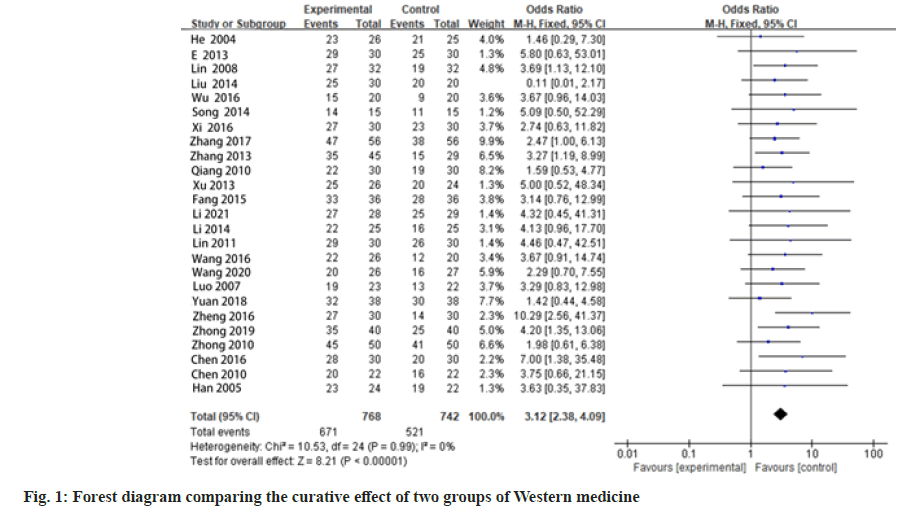
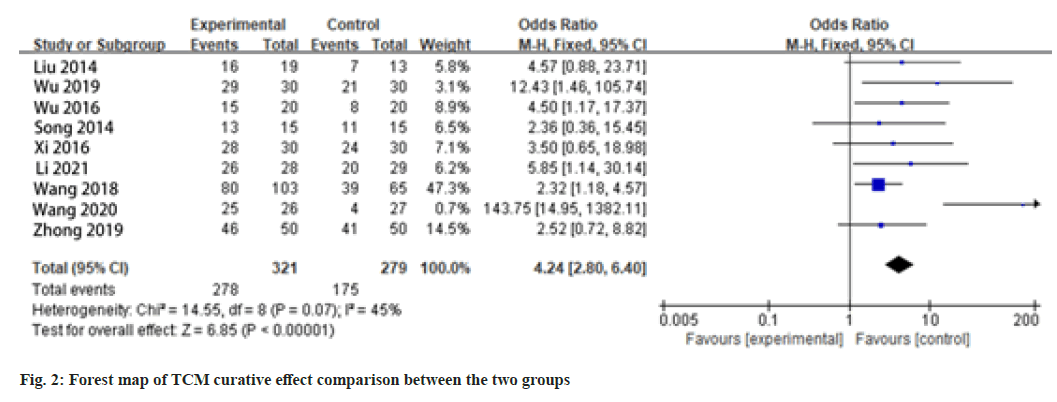
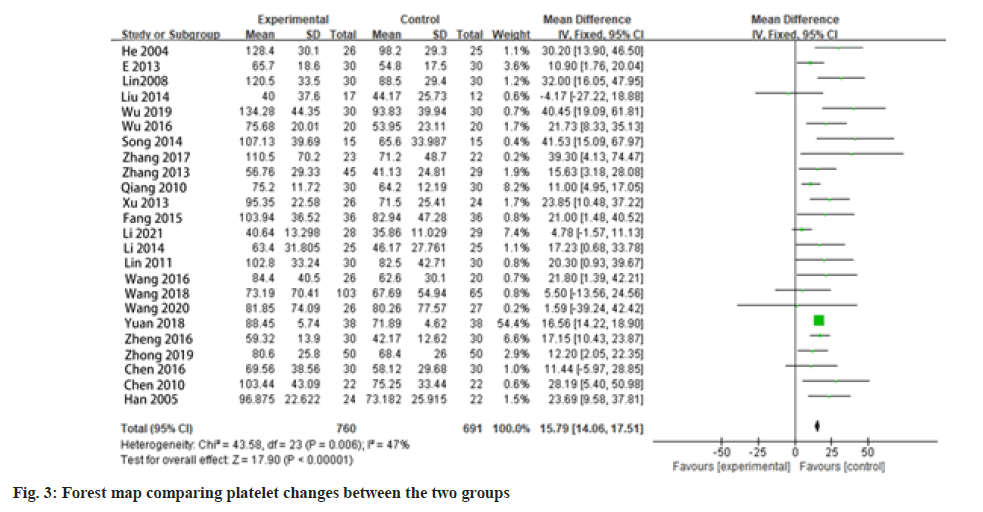
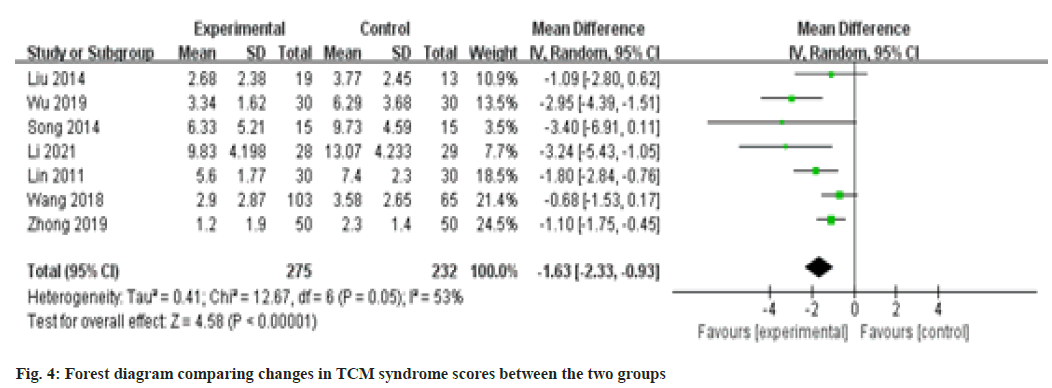




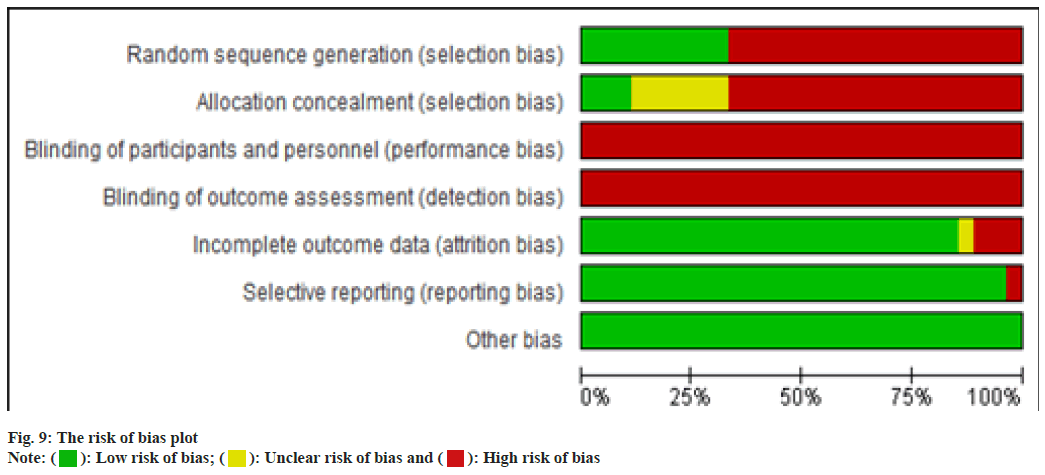
 High risk of bias
High risk of bias